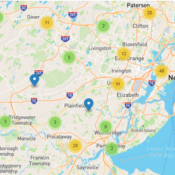Tech & High Demand Define NJ’s Health Industry
The health services industry faces unprecedented challenges as the coronavirus pandemic stretches into its fifth month. The industry was already a major employer in the Garden State pre-pandemic, but it will need to lean on technology and innovation to meet the challenges of the future.
Trends: The health services industry gained 95,823 jobs between 2010 and 2019, with total employment surpassing 589,000 jobs in 2019, according to the US Bureau of Labor Statistics (BLS). By the time COVID-19 hit, the industry employed over 612,000 or 13.5% of the state’s civilian labor force, according to data from the New Jersey Department of Labor and Workforce Development.
The number of health services firms has also increased from 25,455 in 2010 to 36,655 firms last year. Adding 11,200 new businesses in a single decade is a good indication of a healthy state-level industry.
Wages: On average, a health services worker in New Jersey earned $55,433 in 2019, an increase from $47,094 in 2010, according to the BLS. Workers in Morris County earned the most, with average earnings of $65,676 in 2019, while workers in Sussex County were paid the least, earning an average $44,628.
It’s important to note, however, that health services wages differ substantially based on the occupational position held. For example, in New Jersey, home health aides and personal care aides earned on average $27,200 in 2019, while a family medicine physician earned $215,980.
Innovations: According to Focus NJ’s Future of Work – Industry Series Study, the continued integration and advancement in technologies and artificial intelligence will allow for more accurate diagnoses, make healthcare more accessible, and allow for better integration of specific tasks. In addition, the emergence of new technologies is likely to provide cost-effective, faster, and more effective solutions for disease and illness.
These innovations will require both upskilling and reskilling with emphases on big data & analytics, cybersecurity & information technology, 3D scanning & printing, robotics, nanotechnology, and simulation & virtual reality.
Today’s In-Demand Workforce Needs: Before the future is here, however, the industry must confront today’s unmet demand for key skilled positions in addition to the tremendous pressures providers face combating coronavirus. According to the “Future of Work – Industry Series Study,” today’s in-demand careers are registered nurses, nurse practitioners, licensed practical nurses, direct care workers, nurse managers, and office directors. Filling open positions in these occupations, while not necessarily new skill sets, is imperative to the stability of the industry moving forward.
**This content was originally created for the NJ Business Magazine**





